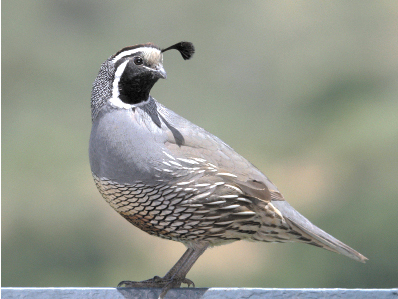
The California Quail, Callipepla californica, also known as the California Valley Quail or Valley Quail, is a small ground-dwelling bird in the New World quail family. It is the state bird of California
These birds have a curving crest or “plume” that droops forward – black in males and brown for females; the flanks are brown with white streaks. Males have a dark brown cap and a black face with a brown back, a grey-blue chest and a light brown belly. Females and immature birds are mainly grey-brown with a light-colored belly. Their closest relative is Gambel’s Quail which has a more southernly distribution and a scalier appearance. The two species separated about 1-2 mya ago, during the Late Pliocene or Early Pleistocene(Zink & Blackwell, 1998).
The California Quail is a highly sociable bird that often gathers in small flocks known as “coveys”, and one of the daily communal activities is the taking of dust baths. A family of quail will select an area where the ground has been newly turned or is soft, and using their underbellies, will burrow downward into the soil some 1-2 inches. They then wriggle about in the indentations they have created, flapping their wings and ruffling their feathers, causing dust to rise in the air. They seem to prefer sunny places in which to create these dust baths, and an ornithologist is able to detect the presence of quail in an area by spotting the circular indentations left behind in the soft dirt, some 3-6″ (7-15 cm) in diameter.
They are all-year residents. Although this bird coexists well at the edges of urban areas, it is declining in some areas as human populations increase. They were originally found mainly in the southwestern United States but they have been introduced into other areas including British ColumbiaHawaii, Chile, New Zealand, and to Norfolk Island and King Island in Australia
These birds forage on the ground, often scratching at the soil. They can sometimes be seen feeding at the sides of roads. Their diet consists mainly of seeds and leaves, but they also eat some berries and insects. If startled, these birds explode into short fast flight. Given a choice, they will normally make their escape on foot.
Their breeding habitat is shrubby areas and open woodlands in western North America. The nest is a shallow scrape lined with vegetation located on the ground under a shrub or other cover. The female usually lays around 12 eggs. Once they are hatched, both parents look after the young.
My Thoughts on Raising California Valley Quail.
The Valley Quail do better on the ground than on wire, due to their nervous nature. The ground however should be dry so a drier climate would work best. There are a lot of breeders that do raise these quail on wire, with success. I would recommend giving them a little more room than you would a Bob White or Coturnix. It is also a good idea, when raising these quail to start them off by adding an antibiotic to their water. Due to their nervous nature the valley quail can become stressed rather easily. When they even after they reach maturity and you notice they seem stressed, it is a good idea to add some antibiotic to their water. This actually holds true when raising any type of quail.
This Quail will actively breed in captivity, their natural laying season is May through June. Also remember to follow the general rule when raising quail, to not add new quail to the an existing flock during breeding season. The new quail would be killed quickly. Only add new quail to an existing flock in winter or colder months of the year. Incubation time 22 to 23 days using the same settings as for the Bob White Quail. Find all incubation temperature and humidity settings in the beginners guide.


